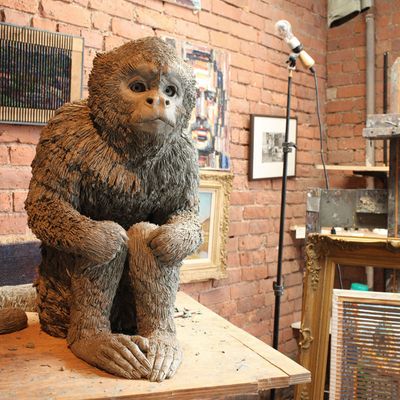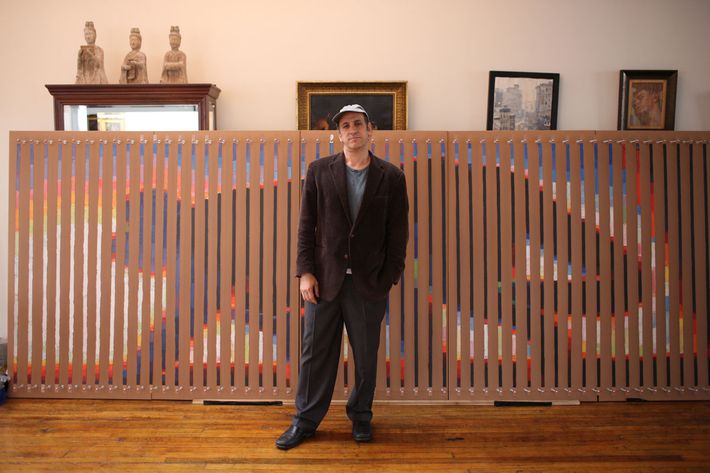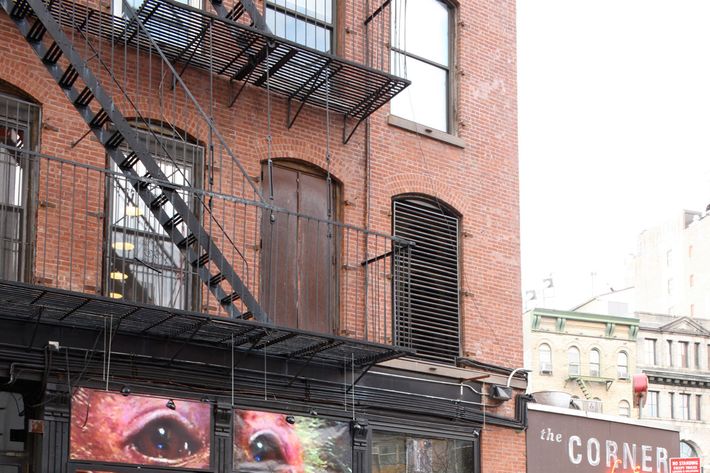
When I met Allen Hirsch — accomplished painter, Nolita landlord, exotic pet owner — in his apartment last Tuesday, his pet pig was also at the door. Does it have a name? “I just call him pig,” Hirsch says, his baseball cap barely containing his graying hair. He’s carrying a Duane Reade bag filled with Red Bulls, and he has the baggy, haggard look of someone who has been in mourning for longer than they can make sense of. And Hirsch has. Since January, Hirsch has been grieving his “first child” — his pet monkey, Benjamin.
To honor Benjamin, a Capuchin monkey, Hirsch has embarked on the most personal project of his life. A successful artist who has painted Bill Clinton for the National Portrait Gallery and Muammar Qaddaffi (among others) for the cover of Time, Hirsch has spent months creating art about nothing but Benjamin. Last weekend, beneath a movie billboard on a corner of Kenmare Street, Hirsch erected a large installation of his own. It’s the most public piece he’s created: a colorful silhouette of Benjamin on all fours that, because of Hirsch’s string-painting technique, glows out of the negative space that surrounds it. “I just want to do honor and homage to this incredible love story,” Hirsch says.
The story began in Venezuela in 1997. Visiting on business, Hirsch came across a box with two monkeys inside of it — skittish about providing potentially damning details, he won’t say how. One monkey was dead; the other was Benjamin. Benjamin was emaciated and orphaned, and Hirsch, an animal-liker if not quite -lover, nursed him back to health. He didn’t expect to keep him, but soon realized he had no choice. “There are certain things that come to you at certain parts of your life that really touch you deeply, and he just went right to my heart.”
And so Benjamin came to America to live with Hirsch at his farm upstate and his apartment in Nolita. He became a fixture of the neighborhood, going for daily walks with Hirsch (if turned away at a shop’s door, Hirsch would say, “the sign just says no dogs allowed”), turning the lights on and off at Hirsch’s synagogue, earning a shout-out on Regis and Kelly. Wherever Hirsch went, so did Benjamin. “I have to keep him on a tether,” said Hirsch, who still lapses into the present tense when he talks about Benjamin, now ten-months gone — “sort of like an umbilical cord really.”
Benjamin was a pet, sure, but to Hirsch he was something else — “his own person.” “The thing about him versus a dog is you tell a dog what to do and the dog’ll do it,” he said. “I tell Benjamin what to do, and he’ll think to himself first, ‘Should I do this or not?’” Hirsch found sentience in Benjamin, but without the messy, awkward expectations of humanity. “For me, being around him was like being alone but having company at the same time. He was cool about everything.” Hirsch called Benjamin “my little caveman.”

Benjamin, of course, isn’t the only primate to have forged a kinship with a human, and that’s not even counting Caesar and James Franco’s bond in Rise of the Planet of the Apes. Nim, the sign-language speaking chimp, was friendly until he got lonely back in the seventies. And Travis, Sandy Herold’s chimp in Connecticut, was her best friend until one day he turned so violent she had to stab him.
Benjamin also bit somebody’s face — though far, far less severely. In July 2010 a couple was staying at Hirsch’s property upstate. Hirsch wasn’t there, but swears Benjamin was locked in his cage as usual. Yet somehow — the events are disputed — Benjamin attacked the woman, leaving a gash on her left cheek that was bloody enough to get the attention of the Early Show. News reports say authorities wanted to euthanize Benjamin. But Hirsch, who says he can’t talk about the incident because there’s still a civil suit pending, wouldn’t let it happen. So, according to those same reports, he took his monkey on the lam.
Hirsch confirms he took Benjamin out of New York, to where all people go when they get too old: Florida. Hirsch checked Benjamin into an animal sanctuary there, but days later the monkey’s breathing changed. The vet found a tumor on his chest. “I tried to do everything for him at that point,” Hirsch says, “I started to research all around the world about treatments for cancer and alternative therapies. I was talking to doctors in the Sarcoma Center in Texas, I was talking to vets in California, New Mexico, in Pennsylvania, in New York.” But it wasn’t enough. In January, while Hirsch was in Venezuela, Benjamin died at the age of 14.
Hirsch was inconsolable. He was pushed “as far as my emotions could go to sadness and misery. He was like a part of me. He was really a part of me. We were like a unit together.” He had the vet send Benjamin’s body to New York. “When I unwrapped him, he was just this beautiful creature. He didn’t have agony on his face or anything. He was a sort of a dormant creature.” For the first time, Hirsch began to paint Benjamin in earnest. And mold a cast of his dead body. And create sculpture in his image. Even after he buried Benjamin — the ground upstate was originally too hard to dig up in the middle of the winter — he just kept creating Benjamin art. He even made a video, “Requiem for Benjamin,” and put it on YouTube. Ultimately he made enough art to mount an exhibit, which opens Tuesday at the Storefront for Art and Architecture.
Sucking down his Red Bull, Hirsch gives me a tour of “Benjamin’s room,” which is now his shrine. There was a makeshift votive candle in here up until a few weeks ago, when it set the room on fire. The firemen told him he had to leave the room to let them work, but Hirsch wouldn’t leave Benjamin’s side: “I was guarding the sculpture; it was like my baby.”
This sculpture is the manifestation of Hirsch’s grief. It rests on a platform in the center of the room, a 100-plus pound plasticine monkey, sitting with his knees crouched up into its stomach. Hirsch says there’s more than $1,000 of clay in there. “If it’s not the spirit of him in there, it’s like the exact negative imprint of my feelings for him,” Hirsch says, his body languid despite all the Red Bull. “It’s sort of a way to forget him, and him being missing, and just taking out what’s left inside of me and transposing it on something else.”
We look around the room. String paintings of Benjamin’s silhouette stalk more than one of the walls. Pictures of Hirsch and him are tucked into corners. A series of leg casts Hirsch jerry-rigged for Benjamin lie mounted on a board near the floor. This is not a shrine, this is a tomb — and it’s unclear whose.
“This launching of this project is an opening, but it’s also a closing. This is my full expression of my grief and my love for him and I’m sending it out in the world,” he tells me, eyes haunted, his mind spinning in and out of so many memories he can’t articulate any single one of them. “I wanted the story to have an ending.”






























